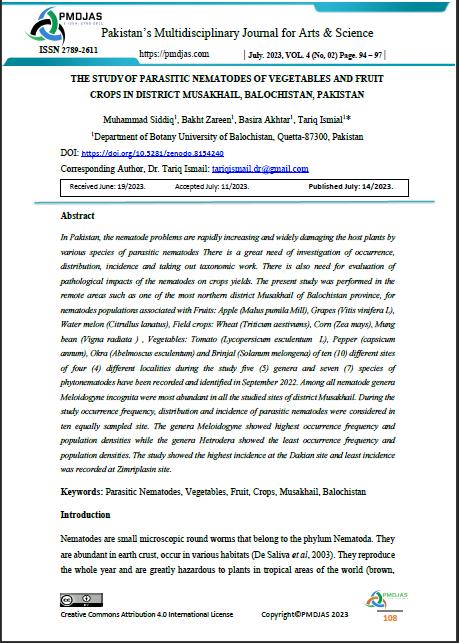The Study of Parasitic Nematodes of Vegetables and Fruit Crops in District Musakhail, Balochistan, Pakistan
DOI:
https://doi.org/10.5281/zenodo.8154240Keywords:
Parasitic Nematodes, Vegetables, Fruit, Crops, Musakhail, BalochistanAbstract
In Pakistan, the nematode problems are rapidly increasing and widely damaging the host plants by various species of parasitic nematodes There is a great need of investigation of occurrence, distribution, incidence and taking out taxonomic work. There is also need for evaluation of pathological impacts of the nematodes on crops yields. The present study was performed in the remote areas such as one of the most northern district Musakhail of Balochistan province, for nematodes populations associated with Fruits: Apple (Malus pumila Mill), Grapes (Vitis vinifera L), Water melon (Citrullus lanatus), Field crops: Wheat (Triticum aestivums), Corn (Zea mays), Mung bean (Vigna radiata ) , Vegetables: Tomato (Lycopersicum esculentum L), Pepper (capsicum annum), Okra (Abelmoscus esculentum) and Brinjal (Solanum melongena) of ten (10) different sites of four (4) different localities during the study five (5) genera and seven (7) species of phytonematodes have been recorded and identified in September 2022. Among all nematode genera Meloidogyne incognita were most abundant in all the studied sites of district Musakhail. During the study occurrence frequency, distribution and incidence of parasitic nematodes were considered in ten equally sampled site. The genera Meloidogyne showed highest occurrence frequency and population densities while the genera Hetrodera showed the least occurrence frequency and population densities. The study showed the highest incidence at the Dakian site and least incidence was recorded at Zimriplasin site.
Downloads






